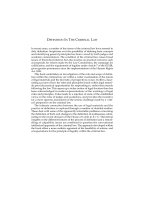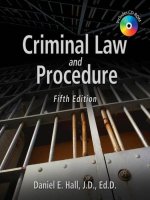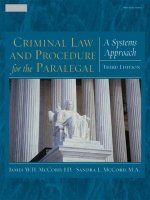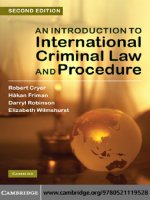Criminal Law and Procedure Fifth Edition docx
Bạn đang xem bản rút gọn của tài liệu. Xem và tải ngay bản đầy đủ của tài liệu tại đây (3.79 MB, 640 trang )
Criminal Law
and Procedure
Fifth Edition
Accounting and Financials for the Law Office • Administrative Law • Alternative Dispute Resolution • Bankruptcy
Business Organizations/Corporations • Careers and Employment • Civil Litigation and Procedure • CLA Exam
Preparation • Computer Applications in the Law Office • Constitutional Law • Contract Law • Court Reporting
Criminal Law and Procedure • Document Preparation • Elder Law • Employment Law • Environmental Law •
Ethics Evidence Law • Family Law • Health Care Law • Immigration Law • Intellectual Property • Internships
Interviewing and Investigation • Introduction to Law • Introduction to Paralegalism • Juvenile Law • Law
Office Management • Law Office Procedures • Legal Nurse Consulting • Legal Research, Writing, and
Analysis • Legal Terminology • Legal Transcription • Media and Entertainment Law • Medical Malpractice Law
Product Liability • Real Estate Law • Reference Materials • Social Security • Sports Law • Torts and
Personal Injury Law • Wills, Trusts, and Estate Administration • Workers' Compensation Law
DELMAR CENGAGE Learning
5 Maxwell Drive
Clifton Park, New York 12065-2919
For additional information, find us online at:
www.delmar.cengage.com
DELMAR CENGAGE Learning
Options.
Over 300 products in every area of the law: textbooks, online courses, CD-ROMs, reference books, companion
websites, and more – helping you succeed in the classroom and on the job.
Support.
We offer unparalleled, practical support: robust instructor and student supplements to ensure the best
learning experience, custom publishing to meet your unique needs, and other benefits such as
Delmar Cengage Learning's Student Achievement Award. And our sales representatives are always ready to
provide you with dependable service.
Feedback.
As always, we want to hear from you! Your feedback is our best resource for improving the quality of our prod-
ucts. Contact your sales representative or write us at the address below if you have any comments about our
materials or if you have a product proposal.
DANIEL E. HALL, J.D., Ed.D.
Criminal Law
and Procedure
Fifth Edition
Australia • Brazil • Japan • Korea • Mexico • Singapore • Spain • United Kingdom • United States
© , , , , Delmar, Cengage Learning
ALL RIGHTS RESERVED. No part of this work covered by the copyright herein may be
reproduced, transmitted, stored, or used in any form or by any means graphic, electronic, or
mechanical, including but not limited to photocopying, recording, scanning, digitizing, taping,
Web distribution, information networks, or information storage and retrieval systems, except as
permitted under Section or of the United States Copyright Act, without the prior
written permission of the publisher.
Library of Congress Control Number:
ISBN-: ----
ISBN-: ---
Delmar
Maxwell Drive
Clifton Park, NY -
USA
Cengage Learning products are represented in Canada by Nelson Education, Ltd.
For your lifelong learning solutions, visit delmar.cengage.com
Visit our corporate website at cengage.com
Notice to the Reader
Publisher does not warrant or guarantee any of the products described herein or perform any
independent analysis in connection with any of the product information contained herein.
Publisher does not assume, and expressly disclaims, any obligation to obtain and include
information other than that provided to it by the manufacturer. The reader is expressly warned
to consider and adopt all safety precautions that might be indicated by the activities described
herein and to avoid all potential hazards. By following the instructions contained herein, the
reader willingly assumes all risks in connection with such instructions. The publisher makes no
representations or warranties of any kind, including but not limited to, the warranties of fi tness
for particular purpose or merchantability, nor are any such representations implied with respect
to the material set forth herein, and the publisher takes no responsibility with respect to such
material. The publisher shall not be liable for any special, consequential, or exemplary damages
resulting, in whole or part, from the readers’ use of, or reliance upon, this material.
Criminal Law and Procedure,
Fifth Edition
Daniel E. Hall
Vice President, Career
and Professional Editorial:
Dave Garza
Director of Learning Solutions:
Sandy Clark
Acquisitions Editor: Shelley Esposito
Managing Editor: Larry Main
Associate Product Manager:
Anne Orgren
Editorial Assistant: Melissa Zaza
Vice President, Career
and Professional Marketing:
Jennifer McAvey
Marketing Director:
Deborah S. Yarnell
Marketing Coordinator:
Jonathan Sheehan
Production Director: Wendy Troeger
Production Manager: Mark Bernard
Content Project Manager:
David Plagenza
Art Director: Joy Kocsis
For product information and technology assistance, contact us at
Professional & Career Group Customer Support, 1-800-648-7450
For permission to use material from this text or product,
submit all requests online at cengage.com/permissions.
Further permissions questions can be e-mailed to
Printed in Canada
1 2 3 4 5 XX 10 09 08
To Stace
Who I love and respect more every year
This page intentionally left blank
Preface to the Fifth Edition
xiii
Acknowledgments
xvii
About the Author
xix
Table of Cases
xxi
PART I
CRIMINAL LAW
1 Introduction to the Legal System
of the United States
3
Federalism
4
Separation of Powers
7
The Structure of the Court System
9
Duties and Powers of the Judicial Branch
14
Comparing Civil Law and Criminal Law
15
Web Links
20
Key Terms
21
Review Questions
21
Problems & Critical Thinking Exercises
21
End Notes
22
2 Introduction to Criminal Law
23
The Distinction between Criminal Law
and Criminal Procedure
24
The Authority of Government
to Regulate Behavior
25
The Purposes of Punishing Criminal Law
Violators
28
Specific and General Deterrence 28
Incapacitation 29
Rehabilitation 29
Retribution 29
Sources of Criminal Law
30
The Common Law 30
Statutory Law 37
Ordinances 37
Administrative Law 38
Court Rules 42
The Model Penal Code 42
Constitutional Law 43
Web Links
46
Key Terms
46
Review Questions
46
Problems & Critical Thinking Exercises
47
End Notes
47
3 The Two Essential Elements
49
Mens Rea
50
Mens Rea and the Common Law 50
Strict Liability 56
Vicarious Liability 60
Current Approaches to Mens Rea 62
Proving Mens Rea 64
Motive 65
vii
Contents
viii CONTENTS
Actus Reus
66
Voluntariness 66
Thoughts and Statements as Acts 68
Personal Status as an Act 68
Possession as an Act 69
Omissions as Acts 70
Causation 72
Web Links
79
Key Terms
79
Review Questions
80
Problems & Critical Thinking Exercises
80
End Notes
82
4 Crimes Against the Person
83
Studying Crimes
84
Homicide
85
Homicide and the Common Law 87
Statutory Approaches to Homicide 90
Manslaughter 95
The Model Penal Code Approach to Homicide 98
Life, Death, and Homicide 99
Suicide 100
Corpus Delicti 101
Assault and Battery
101
Aggravated Assault and Battery 102
Mayhem
103
Sex Crimes
104
Rape 104
Nonforcible Rape 106
Sodomy 106
Rape Shield Laws 107
Incest 107
Sex Offenses Against Children 107
Megan’s Laws, Commitment, and Castration 109
Kidnapping and False Imprisonment
110
Kidnapping 110
Parental Kidnapping 112
False Imprisonment 112
Stalking
113
Civil Rights and Hate Crimes
114
Web Links
117
Key Terms
117
Review Questions
117
Problems & Critical Thinking Exercises
118
End Notes
119
5 Crimes Against Property
and Habitation
121
Arson
122
Burglary
123
Theft Crimes
125
Introduction to Theft Crimes 125
Larceny 126
Embezzlement 128
False Pretenses 129
Receiving Stolen Property 132
Robbery 133
Extortion 135
Consolidated Theft Statutes 136
Identity Theft 137
The Model Penal Code Consolidation 139
Destruction of Property 140
Computer Crimes 141
Web Links
145
Key Terms
146
Review Questions
146
Problems & Critical Thinking Exercises
146
End Notes
147
6 Crimes Against the Public
149
Defining a “Crime Against the Public”
150
Crimes Against Public Morality
151
Prostitution and Solicitation 151
Deviate Sexual Conduct 151
Indecent Exposure and Lewdness 156
Obscenity 156
Regulating the Internet 159
Crimes Against the Public Order
163
Riot and Unlawful Assembly 164
Disturbing the Peace 164
Incitement/Advocacy of Unlawful Conduct 166
CONTENTS ix
Threats 166
Vagrancy and Panhandling 168
Crimes Involving Firearms 168
Drug and Alcohol Crimes 171
Crimes Against the Administration
of Government
175
Perjury 175
Bribery 178
Tax Crimes 179
Obstruction of Justice 181
Contempt 182
Crimes Against Sovereignty and Security
183
Treason 183
Sedition and Espionage 184
Terrorism 184
Crimes Against the Environment
200
Clean Water Act 201
Clean Air Act 201
Comprehensive Environmental Response,
Compensation and Liability Act 202
Resource Conservation and Recovery Act 202
Occupational Safety and Health Act 202
Toxic Substances Control Act 202
Federal Insecticide, Fungicide,
and Rodenticide Act 203
Emergency Planning and Community
Right-to-Know Act 203
Endangered Species Act 203
Marine Mammal Protection Act 203
Web Links
205
Key Terms
206
Review Questions
206
Problems & Critical Thinking Exercises
206
End Notes
207
7 Parties and Inchoate Offenses
209
Parties to Crimes
210
Inchoate Crimes
211
Attempt 212
Conspiracy 216
Solicitation 218
Web Links
219
Key Terms
220
Review Questions
220
Problems & Critical Thinking Exercises
220
End Notes
221
8 Factual and Statutory Defenses
223
“Defense” Defined
224
Affirmative Defenses
224
Insanity
225
M’Naghten 226
Irresistible Impulse 227
Durham 227
The Model Penal Code Test 227
Guilty But Mentally Ill 228
Procedures of the Insanity Defense 228
Disposition of the Criminally Insane 229
Insanity at the Time of Trial 231
Duress and Necessity
232
Use-of-Force Defenses
233
Self-Defense 233
Defense of Others 234
Defense of Property and Habitation 235
Imperfect Self-Defense 236
Arrests 236
Infancy
243
Intoxication
244
Mistake
244
Entrapment
245
Alibi and Consent
246
Statutes of Limitation
246
Web Links
248
Key Terms
249
Review Questions
249
Problems & Critical Thinking Exercises
249
End Notes
250
9 Constitutional Defenses
251
Introduction
252
Double Jeopardy
252
x CONTENTS
Self-incrimination and Immunity
255
Due Process and Equal Protection
256
Vagueness and Overbreadth
258
Ex Post Facto and Bills of Attainder
258
First Amendment and Religion
259
First Amendment and Speech
266
Privacy and other Unenumerated
Rights
272
Web Links
277
Key Terms
277
Review Questions
278
Problems & Critical Thinking Exercises
278
End Notes
278
PART II
CRIMINAL PROCEDURE
10 Introduction and Participants
283
Criminal Procedure Defined
284
A Common-law, Adversarial, and Accusatorial
System
284
The Due Process Model
286
The Participants
287
Law Enforcement Officers 287
Prosecutors 289
Judges 295
Defense Attorneys 295
Victims 298
Liability of Governments and Their Officials
300
Web Links
302
Key Terms
302
Review Questions
303
Problems & Critical Thinking Exercises
303
End Notes
303
11 Constitutional Aspects of Criminal
Procedure 305
Introduction
306
Incorporation
306
Expansion of Rights
308
Exclusionary Rule
308
Exclusionary Rule and Exceptions 313
Fruit of the Poisonous Tree
313
Standing
314
State Constitutions and the
“New Federalism”
315
Web Links
322
Key Terms
322
Review Questions
322
Problems & Critical Thinking Exercises
323
End Notes
323
12 Searches, Seizures, and Arrests
325
The Fourth Amendment
326
Privacy 327
Probable Cause 336
Searches and Seizures
341
The Warrant Requirement 341
Exceptions to the Search Warrant Requirement 347
Arrest
373
Defining Arrest 373
The Warrant Preference 376
Arrests in Protected Areas 378
Search Incident to Arrest and the Protective Sweep 381
Executing Arrest Warrants 383
Illegal Arrests 384
Analyzing Fourth Amendment Problems 384
Web Links
388
Key Terms
388
Review Questions
388
Problems & Critical Thinking Exercises
389
End Notes
390
13 Interrogation and Other Law Enforcement
Practices
393
Interrogations, Confessions, and Admissions
394
Miranda 394
Sixth Amendment 405
Voluntariness Requirement 405
CONTENTS xi
Electronic Surveillance
405
Governing Statutes 407
Wiretaps 408
Tracking Devices 410
Stored Communications and Subscriber Records 419
Pen Registers and Trap Devices 420
Pretrial Identification Procedures
425
Lineups and One-Man Showups
426
The Fairness Right 426
Photographs 428
Scientific Identification Procedures 428
Exclusion of Improper Identifications 433
Web Links
435
Key Terms
435
Review Questions
435
Problems & Critical Thinking Exercises
436
End Notes
436
14 The Pretrial Process
439
Introduction
440
Discovery and Investigation
of Criminal Activity
440
Arrest
440
The Complaint
441
Initial Appearance
441
Pretrial Release and Detention
445
Types of Release 445
Eighth Amendment 445
Detention 446
Preliminary Hearing
446
The Formal Charge
447
Indictment and Grand Jury 447
Information 453
Arraignment
455
Pretrial Activity
456
Discovery 456
Motion Practice 460
Pretrial Conference 462
Extradition and Detainers
462
Removal
464
Web Links
465
Key Terms
465
Review Questions
465
Problems & Critical Thinking Exercises
466
End Notes
466
15 Trial
467
Trial Rights of Defendants
468
The Right to a Jury Trial 468
The Right to a Public Trial 469
The Right to Confrontation and
Cross-Examination 472
The Presumption of Innocence/Burden
of Proof 473
The Right to Speedy Trial 474
The Right to Counsel 476
Trial Procedure
480
Voir Dire 480
Preliminary Instructions 481
Opening Statements 482
The Prosecution’s Case in Chief 482
The Defense Case 482
Rebuttal 483
Closing Arguments 483
Final Instructions 483
Jury Deliberations and Verdict 483
JNOV/New Trial 484
Web Links
486
Key Terms
486
Review Questions
486
Problems & Critical Thinking Exercises
487
End Notes
487
16 Sentencing and Appeal
489
Sentencing
490
Sentencing Procedure 490
Forms of Punishment 496
Habitual Offender Statutes 524
Postconviction Remedies
525
Appeal 525
Habeas Corpus 528
xii CONTENTS
Web Links
531
Key Terms
531
Review Questions
531
Problems & Critical Thinking Exercises
532
End Notes
532
APPENDIX A The Constitution of the United States of America
535
APPENDIX B Selected Excerpts from the Model Penal Code
547
Glossary
583
Index
591
xiii
Preface to the Fifth Edition
Like its four previous editions, Criminal Law and Procedure, 5th Edition, is a comprehen-
sive text covering both substantive criminal law and criminal procedure. The importance of
constitutional law to these fields is emphasized, as are practical insights. This book has been
designed for use in undergraduate programs in both legal studies and criminal justice.
Organization of the Text
Because I don’t believe in fixing things that are not broken and because the reviewers and
users of this book have told me that it isn’t broken, I have retained the original organiza-
tion, content, and pedagogy in this edition. This remains a combination textbook and
casebook. The cases are edited and the text written with the undergraduate student in
mind. It is my hope that the writing level of this book will challenge undergraduate stu-
dents without overwhelming them.
All of the pedagogical features of the earlier editions have been retained, includ-
ing highlighted definitions, glossary of terms, table of cases, and a thorough index. The
distinction between chapter questions and chapter problems continues in this text, the
former testing content knowledge and the latter testing the students’ problem-solving and
analytical skills.
Keeping in mind the diverse audience of students and instructors who use this text, I
have designed two general methods of use. The first is as a combination text and casebook.
The second method is to omit the cases and use the text alone. Both methods are possible
because I do not use any case to exclusively teach a point of law. Instead, the cases are used
to illustrate a point in practice and to develop the cognitive skills of students. Accordingly,
if time does not permit it or the educational goals of an instructor are focused elsewhere,
the cases may be omitted without losing substantive content.
The first half of the text covers substantive criminal law, while the second half of the
text discusses both the constitutional dimensions of criminal procedure and the practical
dimensions of the criminal justice process.
Key Features
Ethical Considerations that expose students to ethical questions in criminal law and general
ethical principles and laws that apply to players in the criminal justice system.
Writing Style that challenges but does not overwhelm undergraduate students.
Key Terms that are in bold on first use and clearly defined in the margin.
Cases that reinforce content and promote the development of case analysis skills.
Sidebars that can be used to spark class discussion and student interest in issues involving
the criminal justice system and criminal law.
Exhibits that reinforce textual material and help illustrate important ideas.
Web Links that highlight websites that are germane to chapter materials.
Review Questions that call for content-related answers to reinforce and retain chapter
concepts.
Chapter Problems that are intended to develop critical thinking and problem-solving
skills.
Changes to the Fifth Edition
I have added new material and updated existing material to keep abreast of changes in both
the law and the criminal justice disciplines. The changes and additions include, inter alia,
the following:
• Ethical Considerations is a new feature that appears in every chapter. In this feature,
students are exposed to an ethical question in criminal law or a general ethical prin-
ciple or law that applies to a player in the criminal justice system.
• Recent developments in Fourth Amendment law are discussed, including the law
of seizure of passengers of stopped automobiles, high-speed police chases, and wire-
taps. A discussion of how technology is impacting electronic searches, including the
FBI’s new programs (Magic Lantern, Keystroke) aimed at preventing terrorism, was
added.
• The Supreme Court’s decisions through early 2008 are covered, including, for
example, the lethal injection case (Baze v. Rees [2008]).
• New information on wiretaps, as well as a graph, has been added to the section on
terrorism, treason, and national security.
• The discussion of terrorism (crimes and procedural questions) has been expanded in
several locations in the text.
• All the data, including crime, courts, and law enforcement, has been updated.
• New illustrations and charts have been added to facilitate the students’ understanding
of the readings.
• A note about case excerpts: To this author, there are three objectives of including
judicial opinions in a textbook. The first is doctrinal: to teach the law. The second is
purely cognitive: to develop a reader’s analytical, and more specifically, legal reasoning
skills. The third is to develop the reader’s familiarity with the language and structure
of legal writing. I consider all of these purposes when selecting cases, knowing that not
every case will accomplish all three objectives. In addition, the importance and impact
of a case, its age, the clarity of its language, and my ability to successfully edit it are
considered. I have taken some liberties in my editing. Because ellipses can be distract-
ing to the reader, many citations and footnotes were redacted without any indication
xiv PREFACE TO THE FIFTH EDITION
in the text. The reader is advised to consult the appropriate official reporter for the
complete text.
Please share any ideas you have for improvement of this book with either the publisher
or me.
Ancillary Materials
• New to this edition, the accompanying Student CD-ROM provides additional material
to help students master the important concepts in the course.
• Web page—Come visit our website at www.paralegal.delmar.cengage.com, where you
will find valuable information such as hot links and sample materials to download, as
well as other Delmar Cengage Learning products.
• Online Companion
TM
—The student Online Companion
TM
can be found at www.
paralegal.delmar.cengage.com in the Online Companion
TM
section of the Website.
• WebTUTOR on WebCT and BlackBoard—The WebTutor
TM
supplement to accom-
pany Introduction to Law allows you, as the instructor, to take learning beyond the
classroom. This Online Courseware is designed to complement the text and benefit
students and instructors alike by helping to better manage your time, prepare for exams,
organize your notes, and more. WebTutor
TM
allows you to extend your reach beyond the
classroom.
• The new Instructor’s eResource CD-ROM provides instructors with all the tools they
need in one convenient CD-ROM. Instructors will find that this resource provides them
with a turnkey solution to help them teach by making available PowerPoint
®
slides for
each chapter, an updated Computerized Test Bank and an updated Instructor’s Guide
that includes an outline of the material, answers to chapter questions and chapter prob-
lems, and a test bank of true/false and multiple choice questions. All of these instructor
materials are also posted on our website, www.paralegal.delmar.cengage.com.
PREFACE TO THE FIFTH EDITION xv
Please note the Internet resources are of a time-sensitive nature and URL addresses
may often change or be deleted. Contact us at
This page intentionally left blank
xvii
Acknowledgments
I would like to thank the acquisitions editor, Shelley Esposito and the developmental
editor, Anne Orgren, in seeing this project through to fruition. The project has also ben-
efited from the outstanding editorial work of Deepti Narwat of International Typesetting
and Composition.
Many of the changes in this edition are the result of the insightful and thoughtful
comments of the reviewers. Thanks to each of the following individuals for taking the time
to review and comment on the text:
Robert Diotalevi, Esq., LL.M.
Florida Gulf Coast University
Fort Myers, FL
Karl O. Durand, JD
McIntosh College
Dover, NH
David Hallett, JD
Pioneer Pacific College
Wilsonville, OR
Craig Hemmens, JD, PhD
Boise State University
Boise, ID
Penny Lorenzo, JD
Rhodes College
Phoenix, AZ
Kay Rute, JD
Washburn University
Topeka, KS
This page intentionally left blank
xix
About the Author
A native of Indiana, Daniel E. Hall is Dean of the Hamilton Campus and Professor of
Political Science at Miami University. He was formerly chairperson of the Department of
Criminal Justice at the University of Toledo and Associate Professor of Criminal Justice
and Legal Studies at the University of Central Florida. He has also held adjunct faculty
positions at the Barry University School of Law and the University of Evansville. He earned
his B.S. at Indiana University, J.D. at Washburn University, and Ed.D. at the University
of Central Florida. In addition to experience as a defense attorney in the United States and
assistant attorney general of the Federated States of Micronesia, he has 13 years of experi-
ence teaching criminal law and procedure in higher education. He has authored a dozen
journal articles and another dozen books, all on public law subjects. Daniel has been mar-
ried to Stacey Lynn Hall since 1991. They live in Ross, Ohio, with their daughters, Grace
Kathryn and Eva Joan, and their golden retriever Atticus.
This page intentionally left blank
xxi
ACLU et al. v. National Security Agency, et al., 436
ACLU v. Reno, 119
Aguilar v. Texas, 336–337, 341, 391
Ah Sin v. Whitman, 292
Alabama v. Shelton, 477–478
Allen v. United States, 483
American Library Association v. Pataki, 163
Andresen v. Maryland, 423
ApolloMedia v. Reno, 119
Apprendi v. New Jersey, 511–512
Argersinger v. Hamlin, 477
Arizona v. Fulminante, 405
Arizona v. Hicks, 390
Arizona v. Washington, 278
Ashcroft v. ACLU, 208
Ashcroft v. Free Speech Coalition, 160–163
Ashe v. Swenson, 253–254
Atkins v. Virginia, 250, 503–506
Atwater v. City of Lago Vista, et al., 379–381
Austin v. United States, 518–519
Baldwin v. New York, 487
Barclay v. Florida, 271
Barker v. Wingo, 474, 476
Barnes v. Glen Theater, Inc., 156
Batson v. Kentucky, 487
Baze v. Rees, 500–503
Bazeley’s Case, 147
Bearden v. Georgia, 533
Beck v. Ohio, 390
Beckwith v. United States, 397–398
Bell v. Wolfish, 372, 502
Table of Cases
Berkemer v. McCarty, 398
Betts v. Brady, 479
Bivens v. Six Unknown Fed. Narcotics Agents, 310, 390
Blakely v. Washington, 511
Blockburger v. United States, 278
Bolling v. Sharpe, ?
Bond v. United States, 333, 367
Booth v. Maryland, 492
Bordenkircher v. Hayes, 292
Bouie v. City of Columbia, 77
Bowers v. Hardwick, 119, 153, 155, 276
Boykin v. Alabama, 453
Brady v. Maryland, 205, 303, 458–459
Brandenburg v. Ohio, 208
Brendlin v. California, 373, 374–375
Briggs v. Maryland, 142–144
Brigham City v. Stuart, 359
Broadrick v. Oklahoma, 161
Brooks v. Tennessee, 487
Brower v. County of Inyo, [ch. 8], ?
Brown v. Allen, 528
Brown v. Mississippi, 436
Brown v. Texas, 390
Browning-Ferris Industries of Vt., Inc. v. Kelco Disposal, Inc., 521
Burch v. Louisiana, 487
Burdeau v. McDowell, 323
Burgett v. Texas, 487
Burns v. Reed, 304
California v. Acevedo, 369–370
California v. Ciraolo, 390
California v. Greenwood, 320
Callins v. Collins, 399, 497–498
Camara v. Municipal Court of City and County of San Francisco, 365
Campbell v. Sundquist, 154
Capitol News Co. v. Metropolitan Government, 207
Carey v. Musladin, 487
Carroll v. United States, 368, 390
Carson v. United States, 53–54
Casey v. Planned Parenthood of Southeastern Pennsylvania, 274–275
Chambers v. Mahoney, 390
Champlinsky v. New Hampshire, 208
Chandler v. Miller, 365
Cheek v. United States, 180
Chimel v. California, 357, 358–359
xxii TABLE OF CASES
Church of Lukumi Babalu Aye, Inc. v. Hialeah, 259–262
City of Indianapolis v. Edmond, 364–367
City of Little Falls v. Edwin George Witucki, 165–166
Coates v. Cincinnati, 279
Cohen v. California, 166
Coker v. Georgia, 504
Colorado v. Bertine, 367, 391
Commonwealth v. Edmunds, 312, 318–319
Commonwealth v. Hughes, 111–112
Commonwealth v. Ludwig, 323
Commonwealth v. Redline, 119
Commonwealth v. Schnopps, 97
Commonwealth v. Triplett, 323
Commonwealth v. Wasson, 154
Commonwealth v. Wright, 390
Connally v. General Construction Co., 279
Coolidge v. New Hampshire, 351–352, 390
Cooper v. California, 320
Cooper v. Oklahoma, 231
County of Riverside v. McLaughlin, 441, 447
County of Sacramento v. Lewis, 374
Cumbie v. Singletary, 487
Cunningham v. California, 487
Cuyler v. Sullivan, 478
Daubert v. Merrell Dow Pharmaceuticals, 428
Davis v. United States, 436
Dawson v. Delaware, 271
Delaware v. Cannon, 533
Delaware v. Prouse, 365, 370–371
Department of Human Resources v. Smith, 259, 323
Douglas v. California, 279, 527
Douglas v. Wainwright, 471
Dudgeon v. United Kingdom, 155
Dunaway v. New York, 381
Durham v. United States, 227
Dusky v. United States, 250
Earl of Devonshire’s Case, 522
Eddings v. Oklahoma, 532
Edmond v. Goldsmith, 364
Edwards v. Arizona, 401
Eisenstadt v. Baird, 276
Elledge v. Dugger, 472
Enmund v. Florida, 504
TABLE OF CASES xxiii
Escobedo v. Illinois, 394
Estelle v. Williams, 487
Estes v. Texas, 469
Faretta v. California, 479
Fay v. NOIA, 533
Florida v. Bostick, [ch. 12], ?
Florida v. J.L., 337–339
Florida v. Royer, 354
Florida v. Wells, 367
Florida v. White, 390
Ford v. Wainwright, 250, 505
Foucha v. Louisiana, 231
Frisbie v. Collins, 391, 459
Frye v. United States, 428
Furman v. Georgia, 496
Gajewski v. United States, 248
Gargliano v. State, 143
Gebhard v. State, 82
Georgia v. Randolph, 390
Gerstein v. Pugh, 466
Gideon v. Wainwright, 477, 478–479
Ginsberg v. New York, 163
Godfrey v. Georgia, 505
Goldschmitt v. State, 533
Gonzales v. O Centro Espirita Beneficente Uniao do Vegetal, 262–264
Gonzales v. Raich, 7
Gore v. United States, 522
Graham v. Connor, 237–238, 241
Gregg v. Georgia, 496, 505
Griffin v. Wisconsin, 533
Griswold v. Connecticut, 272, 323
Gryczan v. State, 154
Harmelin v. Michigan, 504
Harris v. Coweta County, 239
Helms v. American Security Co., 48
Hensley v. Municipal Court, 533
Henson, In re, 219
Herrera v. Collins, 533
Hiibel v. Sixth Judicial District, 354
Hill v. California, 238
H.J., Inc. v. Northwestern Bell Telephone Co., 131–132
xxiv TABLE OF CASES









